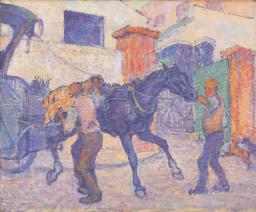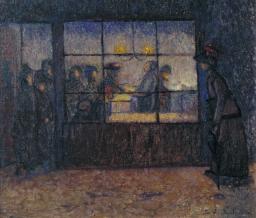Huntly Carter, ‘Art’
The New Age, 9 June 1910, pp.135–6.
ART.
By Huntly Carter.
It is a scientific fact that music evokes a vision of colour; it is a fact that colour evokes a sensation of music. Thus colour has the rare merit of changing men’s atmosphere, of lifting people, so to speak, out of a dull depressing mood into a poetical one of its own. Colour, then, like music, is a physician. Its healing qualities are contained everywhere in nature, in the heavens from whence it springs, in the pictures and poems beneath the heavens. Such healing qualities might be contained in the works of human beings. But, unfortunately, few of us, great or small, are able to accept the atmosphere “given off” by colour. Few of us can feel colour. Many are colour-blind; others, again, are insusceptible to it. Few, indeed, are able to perceive it as it really is. Indeed, to quite three-fourths of the human race their hour on earth is an hour of darkness. Therefore quite three-fourths of the human race are unaffected by colour, except in a hostile form. Pure, clean colour arouses in their honest bosoms an exasperation only equalled by that called forth by the so-called indecent forms of art.
* * *
For example I may point to the exasperation aroused by the attempt of the Impressionists to translate themselves in pure and simple colour. This exasperation has slowly found its way to our shores. To palliate it English painters would seem to have exercised the rare gift which so many possess of painting down to the atmosphere of their audience. This artistic method, no doubt innate in some painters, of which they are unconscious, and affected by others, has its advantages and disadvantages. It allows things to be seen as they are. It flatters the public by permitting it to study its own deficiencies in the colour sense, and it destroys the painter by presupposing in him an arrested development in the same direction. It argues that he is unable to attain that fine shade of receptivity which is necessary to the understanding and use of strong, clean, primitive colour, and to the neglect of the bituminous blasphemies of Reynolds.
* * *
If proof is needed that colour is neglected or but little understood in this country, it may be had at the exhibition of the New English Art Club at Suffolk Street. Here the pictures may be divided into two broad groups, those by colourists and those by monochromists. The successful praise of colour, which is one of the highest achievements in painting, has been undertaken and accomplished by a small number of painters. Within this group there is another small group composed of painters who intimately understand the colour of colour and the colour of shadows. One, who has mastered this knowledge is S.F. Gore, probably the youngest exhibitor, and one with a very promising future. His canvases are a blaze of colour and light. Look at his “Rule Britannia” and note how successfully he has caught the effect of colour and form as seen in the full glare of stage-lighting. The whole scene is a mist of kaleidoscopic splendours; it throws off gleams of iridescence like pearls in a shimmering twilight. Another is Lucien Pissarro, who is carrying on the brilliant traditions of his father. Turn to either of his studies and see how it is bejewelled with patches of fresh tints. In these the tenderest, purest, freshest colours harmonise and melt. Robert Bevan is a third colourist belonging to this individual group. Here, again, in his work are clear vision and clever interpretation, light and colour treated reverently and handled sincerely, and with full understanding. Observe the poetical treatment of “The Barn,” and note how successfully the painter has drawn that delicious veil of soft, mystic, blue atmosphere across the scene, and the fine effect he gains by the introduction of that golden globe of hay, which has evidently fascinated him, and which is the excuse for the painting. To take it out of the composition would be like taking the sun out of the heavens. Observe, too, the very clever qualities of that carefully-placed composition “The Trough.” Herein he furnishes abundant proof of the immense attention he pays to drawing. A fourth is Harold Gilman. Near by, his two sensitive studies testify to his exceptional abilities. The “Lady on Sofa” is a reclining figure caught as it were in a network of charming harmonies; a woman woven in fabric of colour and design. The second, a portrait, is another canvas mosaiced with delicate touches of fresh tints. It fully exhibits the very careful methods of this painter. The colour is put on in separate touches, and each touch is a definite colour, and has a definite meaning. The whole is a work of surpassing merit. I have grouped these four painters because their work has characteristics in common. They do not seek to uphold the academic traditions of the N.E.A.C., which is to be congratulated upon admitting a little fresh blood of fine quality into its exhibition. They conceive and express subject in colour; they work putting the colour on in separate touches all through; they use very simple palettes and make very simple mixtures. They avoid the use of varnishes; their surfaces are, in consequence, matt, and thus their work largely partakes of the character of early tempera. Its advantages are, it does not need to be hung at certain angles to catch the light; it is bright and cheerful and introduces the right note of the joy of life into our dreary existence. The South Pole expedition carries with it a tintometer to test the theory that atmosphere and colour affect the pigmentation of human beings. If it is true that colour has the effect [end of p.135] of entirely changing the tints of susceptible individuals, then it is the duty of susceptible individuals to buy colour that will change them into radiant beings. This means it is their duty to buy the simple, sincere, charming and bright work of the aforementioned four painters. If necessary a further selection may be made from such works by colours as P. Wilson Steer’s “The Muslin Dress,” Miss Alice Fanner’s “Old Mill,” Henry Tonks’s “Rustic Pageantry,” Walter Bayes’s “Port,” Miss A. Hope Hudson’s study of an interior, Joseph Crawhall’s “The Cock,” and such works by those who have not fully caught the craze for strong, clean colour, and by decided monochromists, as F. H. S. Shepherd’s clever canvases, the distinguished landscapes by Professor Holmes, and the interesting and charming studies by Mrs. M. Fisher Prout, Miss Helen Innes (24, 58), Mrs. D.S. McColl (34), Mrs. Eleanor Fells, Ethel Walker’s unusually charming “Seagulls,” and Mrs. Edna Clarke Hall’s beautiful design, “Nude Figure by Cliffs.”
* * *
Though Mr. Will Rothenstein has not quite gone over to the colourists; though he introduces notes of black into a composition in which the figures are coloured, “A Composition Suggesting Sorrow,” this defect is fully compensated for by the general high qualities of his work. For this reason persons of taste and judgment should go to the Goupil Galleries and see the exhibition of Mr. Rothenstein’s paintings and drawings. They will like his very spirited design; and the vital characteristics of Goya contained in the work will appeal to them. They will admire the success with which he reproduces the characteristics of the Jewish race, especially in “Carrying the Law.” In particular they will praise that gem-like study “The White Cliffs,” and the virile drawings of Verlaine, Zola, Walter Pater and Anatole France. If they have time to examine Mrs. Koehler’s charming jewellery they will probably desire to possess a certain sapphire with strange blue lights that mingle with the sheen of pearls and the gleam of enamel that heightens by contrast the glittering gold setting of an exquisite necklace. At the Baillie Gallery they will find an exhibition of water-colour drawings and pastels by J.W. Herald. The subjects, which are mostly personal impressions of nature, are generally conceived and expressed in a low note. Occasionally the painter contrives to strike a more welcome higher key. Perhaps his pastels are the most successful things. They are certainly brilliant and vivid in their way, and their decorative qualities should commend them to those persons who prefer strong, individual work to the usual, pretty, muddy and mediocre stuff. I was too much impressed by a second sight of them at the Gutekunst Gallery. They are the work of a young artist who knows how to make a skilful use of the needle. The exhibits are of fairly equal merit. If I were asked to make a choice it would be “Evening on the Thames” for its depth and mystery, and the tree study for its actual look.
How to cite
Huntly Carter, ‘Art’, in The New Age, 9 June 1910, pp.135–6, in Helena Bonett, Ysanne Holt, Jennifer Mundy (eds.), The Camden Town Group in Context, Tate Research Publication, May 2012, https://www


